Some go to find themselves in India, but that is not the only thing you will find there.
The best safari in India will present you with an enticing mix of experiences. It will seduce all your senses… and leave you with an eternal sense of wonder.

Let us tell you about what you can expect while on safari in India:
About Indian Safari Food
EXPECT SPICE…

Spices
Indian food is ubiquitous throughout the western world. While Indian cuisine has many personalities, it is fair to say that most Indian dishes will contain ample exotic spices.
India has been known as the Land of Spices for centuries and continues to produce more varieties of spice than any other country in the world. In fact, India is responsible for 70% of all the spices on earth.
EXPECT HARMONY…
Indian food theory believes that the perfect meal will beautifully balance the six rasas – sweet (madhura), salty (lavana), sour (amala), pungent (katu), bitter (tikta) and astringent (kasya). Sattvic food (fresh fruits and vegetables) leads you to higher states of consciousness.
Rajasic food (oily and spicy) is the foundation of activity and motion.
Tamasic food (meat and liquor) brings out negative feelings.

Sattvic food
EXPECT EXOTIC…
You don’t have to look far to find foreign flavors in Indian cuisine. From Persian to Central Asian and Mediterranean Greek, Roman and Arab traders all contributed to the food we eat in India today. Similarly, many of the staple ingredients on the Indian menu arrived in India courtesy of the Portuguese. Potato, tomato, refined sugar, and chili, for instance.
Samosas, jalebis and jamuns are all imports.
And so is Chicken Tikka Masala – it was created in Glasgow, Scotland!
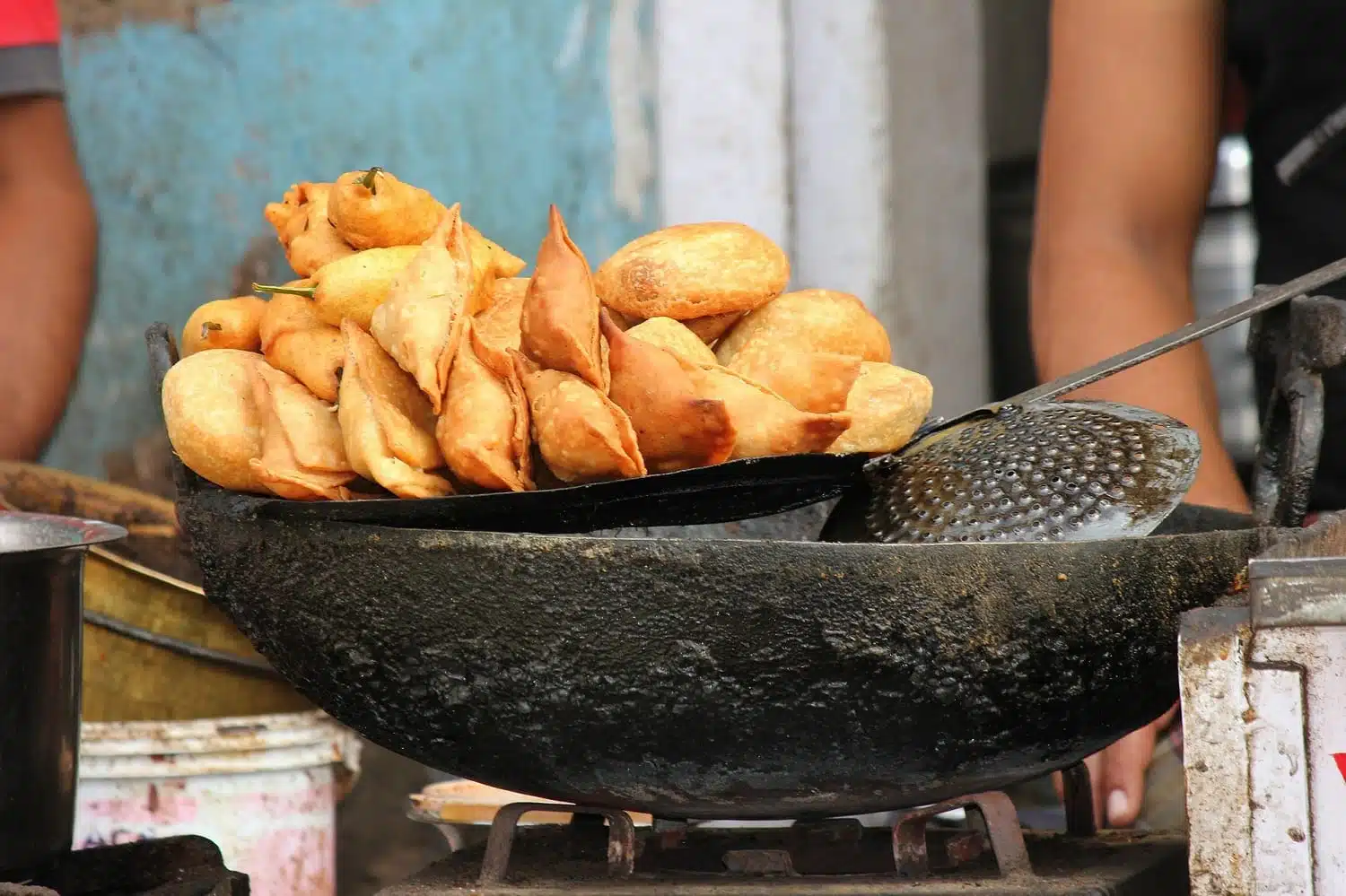
Samosas
EXPECT HISTORY…
At the same time, some of the present-day staples of Indian cuisine like lentils, whole-wheat flour, rice, and pearl millet have been part of the Indian diet for 8000 years.
What to eat in India
You might be adventurous… but you also might not want to eat the stomach of a cow by accident (or order food that is so hot you find yourself weeping).
We find that typical dishes that are not too complicated tend to always leave an excellent first impression and pique interest in the culture and cuisine.

Lentils
Here are the highlights: Some surprising facts
- India has one of the world’s lowest rates of meat consumption per person, but the majority of the country isn’t vegetarian.
- Speaking of spicy – Did you know that India is home to the bhut jolokia or ghost pepper that is grown in Arunachal Pradesh, Assam, Nagaland, and Manipur. India claimed the top spot for the hottest chili in 2007 (it was usurped by the Carolina Reaper in 2013)
- But it is also the place we can thank for our candy! Literally originating from the Indian word khanda, which refers to the crystallization of sugar from sugarcane.
- The triangular Indian samosa can be baked or fried, include a wide variety of vegetables and aren’t necessarily spicy.
- Chutney is a sauce with spice, fruit, and or vegetables. Red chutney is sweet and sour and made with tamarind. Green chutney is usually mint or coriander.
- Raita is a yogurt-based sauce with spices like cilantro, cumin, mint, and other herbs. This is great for taking the edge off spicier dishes.
- If you don’t like naan, are you even alive? This incredibly fluffy bread can (and should) be enjoyed at every opportunity.
- Pakora is most often a dish of battered vegetables (think eggplant, potato, onion, spinach, or cauliflower), but you can also find chicken pakora.
- Sag paneer is soft cheese in a creamy vegetable mixture of greens.
- The humble chicken magically transforms into a tandoori chicken in India. A blend of turmeric, cayenne pepper, chili powder, and paprika accounts for the bright red/orange color of this dish. It might look fiery, but tandoori chicken is usually not spicy.
- Chicken korma or butter chicken are both similar to stew. A korma is slightly sweet, smoky, and nutty.
- Chana masala is similar to a vegetarian chili with beef replaced by chickpeas. Garam masala (pepper, cloves, cinnamon, cumin, cardamom) chili, garlic, onions, and tomatoes are stewed with garbanzo beans.
- Snack on the very flavorful surprise that is the different temperatures and flavors of a Dahi puri.
- Indian donut holes are known as gulab jamun and glazed with rosewater syrup. Kheer is jazzed-up rice pudding.
- India’s brewing culture is 5000 years old. From the Kallu in south India to the millet-based beers of northeastern India, the local tipples are part of the Indian culinary tradition.
- A thali or set meal is a platter of different Indian dishes.

Women working
Indian Food By Region
Kolkotta
Do try a Kati Roll (fried egg topped with paratha, skewered meat or marinated paneer, onions, chilies, lime, and sauces)
Kashmir
Do try Gustaba, Tabak Maz, Dum Aloo, Haak or Karam ka Saag
Chandigarh
Do try Butter chicken, Tandoori Chicken, Mutton Pulao
Haryana
Do try Kachri ki Sabzi, Cholia, Chaach-Lassi, Bajre ki Khichdi
Rajasthan
Do try Dal-Baati-Churma, Ker-Sangari, Lal Maas Gatte, Pyaaz ki Kachori
Gujarat
Do try Thepla, Dhokla, Khandvi, Handvo, Panki
Punjab
Do try Chole Bhature (spiced chickpea curry and a deep-fried bread balloon), Dal Makhani, Makke di Roti-Sarson da Saag Chana-Bhature, Amritsari, Manchchi and Kulcha
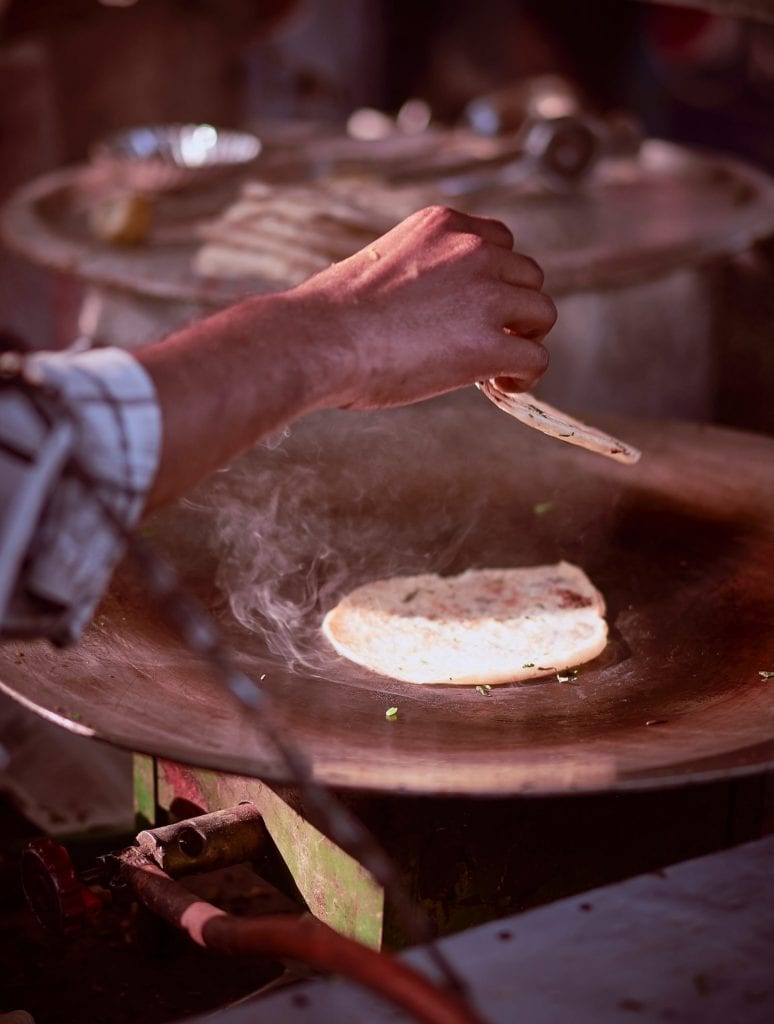
Kulcha
Madhya Pradesh
Do try Lapsi, Bafla, Bhutte ki Khees, Bhopali Kebabs
Maharashtra
Do try Shrikhand, Thalipeeth, Vada Pao, Modak
Karnataka
Do try Bisi Bele Bhaat, Kesari Bath, Mysore Pak, Dharwad Pedha, Chiroti
Kerala
Do try Sadya meal, Avial, Malabar Parotha, Payasam, Irachi Stew
Tamil Nadu
Do try Appam, Dosai, Idli, Sambhar, Rasam, Chettinad chicken, Pongal
Pondicherry
Do try Kadugu Yerra, Vendakkai Patchaddy
Chhattisgarh
Do try Bafauri, Kusli, Red Ant Chutney
Goa
Do try Vindaloo, Xacuti, Bibinca, Prawn Balchao
Orissa
Do try Fish Orly, Khirmohan, Rasabali, Chhenapodapitha
West Bengal
Do try Bhapa Illish, Rosogulla, Mishti Doi
Meghalaya
Do try Jadoh, kyat
Tripura
Do try Chakhwi Mwkhwi, Muitru
Mizoram
Do try Zu
Manipur
Do try Iromba, Kabok, Chakkouba
Nagaland
Do try Momos, Rice Beer, Cherry Wine
Delhi
Do try Chaat and Pani Puri (this is India’s most famous street food. It is a sweet, sour, spicy, tangy, crispy puff ball filled with mashed chickpeas, potatoes, spices onion and flavored with mint or tamarind), Tandoori Chicken, Paranthe, Nagauri-Halwa, Chole Bhature
Assam
Do try Maasor Tenga, Pitha
Arunachal Pradsh
Do try Apong
Sikkim
Do try Momos, thukpa, Gundruk, Phagshapa, Sael Roti
Jharkhand
Do try Thekua, Pua, Pittha, Marua-ka-Roti, Bihar Litti, Sattu, Khaja, Khubika Lai, Anarasa, Tilkut
Uttar Pradesh
Do try Kebabs, Biryanis, Bedmi Aloo, Kachori, Halwa, Benarasi Chaat
Uttarakhand
Do try Aloo ke Gutke, Kaapa, Jhangora ki Kheer, Chainsoo
Andra Pradesh
Do try Hyderabadi Biryani, Mirchi ka Salan, Ghongura pickle, Korikoora

Hyderabadi Biryani
Photo by Wikimedia
Himachal Pradesh
Do try Sidu, Aktori, Dham
INDIAN FOOD IS WORLD FAMOUS FOR GOOD REASON.
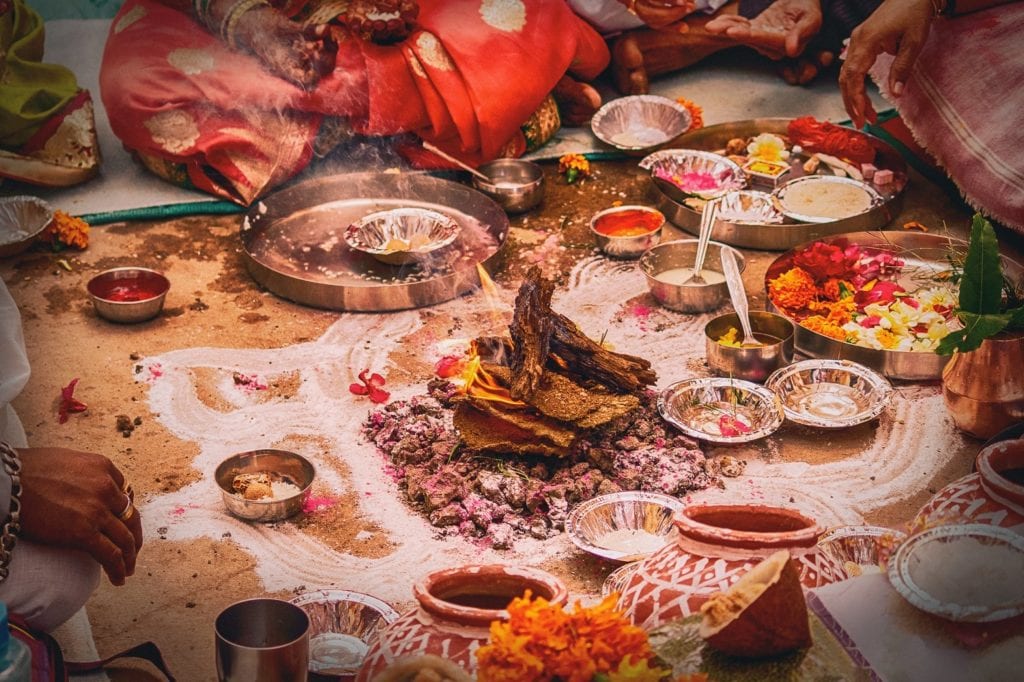
Circuit House
About Indian wildlife
Almost 22% of India is covered in a dense forest. The country boasts 104 national parks and is home to a plethora of wild creatures, birds, and reptiles.
Some of the wildlife safari highlights include five big cats, wild water buffalo, Asiatic elephants, Great Indian rhinos, Asiatic lions, Indian leopards, giant Indian squirrels, the Indian wild bore, Indian wild ass, gaurs, blackbuck, and nilgai. And you may also spot venomous snakes and giant lizards in India.
Here are the most notable of India’s incredible and extensive wildlife safari offerings
THE BIG ONES

Elephants
Endangered Asiatic elephant
These graceful mega-herbivores have been threatened by the degradation, fragmentation, and loss of their habitat. South India’s grasslands and forests are where most of these elephants can be found.
Great Indian rhinoceros
Native to the Indian subcontinent, the Indian rhinoceros habitat is primarily in the northeastern Indian states with Pobitora Wildlife Sanctuary and Kaziranga National Park being home to the highest density of Indian rhinos in the world.
Wild water buffalo
An ancestor of the domestic water buffalo, the 4000 members of this endangered species, live only in protected areas in and around Kaziranga, Manas and Dibru-Saikhowa National Parks, Laokhowa Wildlife Sanctuary and Bura Chapori Wildlife Sanctuary, in a few scattered pockets in Assam and around D’Ering Memorial Wildlife Sanctuary in Arunachal Pradesh.
Indian Bison or Gaur
The largest extant bovine species is native to the Indian subcontinent, and this gentle giant can be found in mountainous and forested areas of Karnataka, Assam, Bandipur, Kaziranga and Manas National park in India.
SNAKES AND REPTILES

King Cobra
King Cobra
The longest of all living venomous snakes feeds only on other snakes. You can spot this cannibal in the Agumbe Rainforest in Shimoga district of Karnataka, in Periyar National Park of Kerala, in Sundarbans National Park of West Bengal, in the Kaziranga National Park of Assam, in the Srivilliputhur Wildlife Sanctuary of Tamil Nadu
Indian Rock Python
India is home to many python species, such as the Burmese python and the reticulated python. They are not venomous but can deliver a painful bite.
Mugger Crocodile
A very skilled predator, the mugger can be found commonly throughout rivers, freshwater lakes, and swamps in India. They share the Indian river system with the smaller Gharial and the saltwater crocodile.
Gharial
The longest crocodilian lives in the river systems of the Son River, the Mahanadi in Satkosia Gorge, the Katarniaghat, and the Chambal River.
Bengal Monitor
One of the most giant monitor lizards can be found on the Indian Subcontinent – they can be entirely arboreal although they hunt on the ground.
DEER

Chital
Blue bull or Nilgai
The biggest Asian antelope is one of the animals you are likely to see most frequently if you go on an Indian safari. A diurnal creature the Niglai can be found inhabiting Indian grasslands with a range covering national park plains and low hills with shrubs.
Blackbuck
The fastest running land animal in India can reach a speed of up to 50 m/h (80 km/h) as they evolved with the cheetah as their main predator. The sole member of its genus is protected and can be found in its native grassy plains.
Spotted Deer or Chital
Known for being big and having big antlers, this grass feeder is a common sight throughout the Indian subcontinent.
Sambar Deer
They have the most massive antlers of all deer in India and make excellent prey for the cats in the tiger reserves in India.
Barasingha
The state animal of Madhya Pradesh is a swamp deer that is renowned for its impressive antlers and can be found in the Kanha National Park of Madhya Pradesh and six further localities throughout Uttar Pradesh.
Ibex or Nilgiri Tahr
Endemic to the Nilgiri Hills of South India, the state animal of Tamil Nadu loves the open montane grasslands of the Western Ghats. It is one of several species of wild goats found in India.
Sangai deer
Brown antlered, it is endangered and can be found only in the floating marshy grasslands of the Keibul Lamjao National Park around Loktak Lake.
Kashmir stag or hangul
A subspecies of native elk that lives in the valleys and mountains of the Kashmir Valley. It is Critically Endangered.
Indian wild ass or Khur
The sanctuary in Little Rann of Kutch in Gujarat is the biggest stronghold of the 4000 individuals remaining of the Indian wild ass population.
PRIMATES

Lion-tailed macaque
Lion-tailed macaque
Endemic to the Western Ghats in South India, this diurnal rainforest dweller spends most of its life in evergreen forests.
Golden langur
One of the most endangered primates, the Gee’s golden langur, can be found in a tiny region of western Assam. It is not the only Indian langur.
CATS
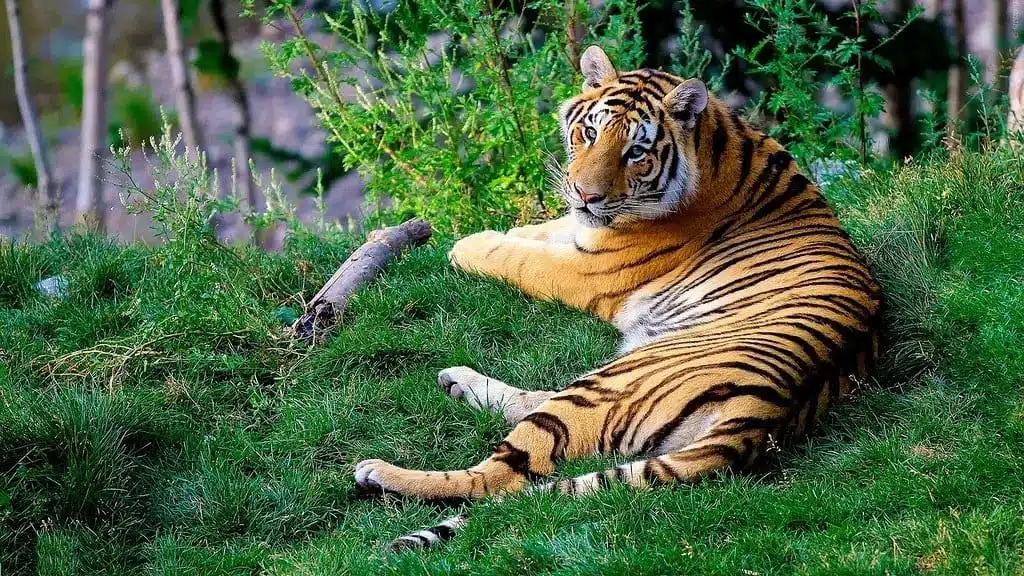
Bengal tiger
Bengal tiger
There are less than 2000 Bengal tigers left in the wild. The second most giant wild cat, it is very adaptable and lives across a wide variety of habitats. The Bengal tiger is endangered, and conservation efforts continue throughout tiger reserves in India.
Asiatic lion
A single population of around 500 Indian lions lives in the Gir National park of Gujarat and the wild forest of Junagarh.
Indian Leopard
A relatively healthy population of between 12 and 14000 Indian leopards live throughout a varied habitat in India. The color of their coat differs subtly with a paler coat in the desert, a greyer in colder climes, and more ochre coloring in the rainforest.
Black Panther
Predominantly found in the Western Ghats, the best place to spot the black color variant of the Indian Leopard is in Kabini Wildlife Sanctuary, Bhadra Wildlife Sanctuary, and Dandeli Wildlife Sanctuary.
Snow Leopard
A large alpine and subalpine wild mountain cat, the snow leopard of the Himalayas, may be seen in the states of Jammu and Kashmir through to Arunachal Pradesh.
Clouded Leopard
The smallest of India’s wild cats, this excellent tree climber can be found in the Himalayan foothills of northeast Indian states.
Indian civet
There are six species of wild civet on the Indian Subcontinent. The Malabar large spotted civet is the biggest and endemic to the Western Ghats.
BEARS AND PANDAS
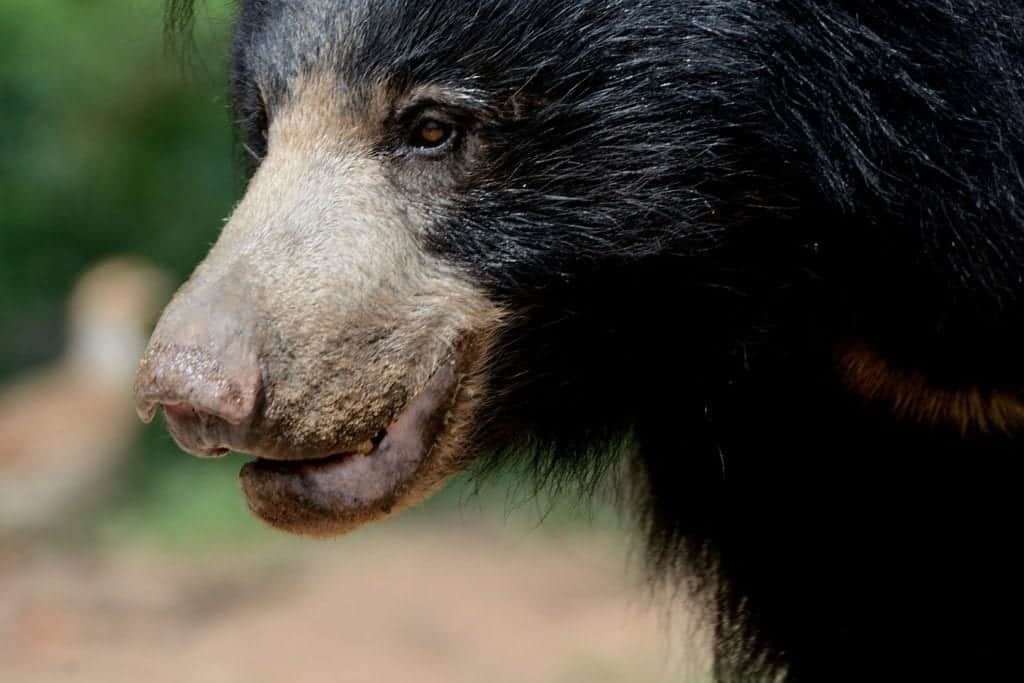
Sloth bear
The Sloth Bear
There are four species of wild bears in India. The distinctive, lanky sloth bear is native to the Indian subcontinent and only dines on insects. The species is vulnerable due to the destruction of their natural habitat for economic gains, and they are also sought after by poachers as their gall bladders meet an illegal demand in Asia.
Himalayan bears
The omnivorous Himalayan brown bear, Himalayan black bear, Eurasian brown bear, and Asian black bear are four most common subspecies of Black and Brown bears found in India. These bears all hibernate in a den during the winter.
Red panda
The endangered red panda is native to the eastern Himalayas and can be found in Sikkim, western Arunachal Pradesh, Darjeeling district of West Bengal, and parts of Meghalaya in India.
OTHER HUNTERS

Indian wolf
Striped Hyena
A scavenger, this monogamous creature, is the smallest of the true hyenas.
Honey badger or ratel
With few natural predators, this carnivore lives mostly in the Western Ghats.
Indian Wolf
An intermediate-sized subspecies of the grey wolf shares India with the Himalayan wolf and the Tibetan wolf.
Indian Wild dog or Dhole
An endangered species, the dhole is highly social and hunt ungulates in packs.
Indian jackal
A golden jackal native to the lowlands on the outskirts of towns and villages of India, this canid species is highly adaptable to urban life.
Parks in India
India is the wildlife safari enthusiasts dream. Your Indian safari can include a range of thrilling experiences, including game drives through the jungle and hiking on foot. With so many national parks, choosing which ones to go to can be a challenge.
Here are some of our favorites:
The elephant grass, cane, forest, and swamps of Kaziranga are home to many creatures. This remote park is famous for its one-horned rhino but also features wild buffalo, sambar, wild boar, the endangered barasingha or swamp deer, otters, dolphins, birds and the highest density of tigers in tiger reserves in India (although the lush jungle may make them difficult to spot).
Where to stay:
Diphlu River Lodge
Located amongst farmland and forest, this eco-lodge is around 15 minutes by road from the park.
Every one of the 12 rooms is set on stilts and constructed mostly from wood and bamboo. The design ethos is rustic and traditional.
Views overlook the River Diphlu, and the fusion cuisine has local Assamese and continental influences.

Photo by Diphlu River Lodge
CORBETT TIGER RESERVE IN INDIA, UTTARAKHAND
Along the Himalayan Foothills on the Ramganga River, the Jim Corbett park is the oldest established national park in India. The naturalist’s reputation lives on as an inspiration to continue preserving the wildlife of India.
This tiger reserve in India has 580 bird species, wild elephants, marsh crocodiles, and gharial.
Where to stay
Aahana Resort in Corbett
Sustainability lies at the heart of this uber-luxury resort, which is ideally located between the dense reserve jungle and a local farming village.

Photo by Aahana Resort at Jim Corbett
Home to one of India’s largest populations of the endangered tiger as well as leopards, sloth bears, wild bears, and many birds, it is the place where you can expect to find both beauty and the beast.
Where to stay
The Serai Bandipur
Located where the Eastern and Western Ghats flow together, the Serai is a premium resort in a haven for wildlife safaris in India. Views of the Nilgiris mountain range are spectacular.

Photo by Serai
Located near the popular resort and spice trading town of Thekkady in the Cardamom hills, the forest of this sanctuary bursts into life every morning as birds and monkeys chatter and a boat trip on the lake may bring elephant, gaur and deer sightings.
Visit a spice plantation to see how crops such as pepper and nutmeg come into existence.
Where to stay
Spice Village, Thekkady, India
Set within a garden of pepper vines, cardamom plants, and spices, the property is part of the CGH Earth group of eco-friendly and community aware pioneering hotels.

Gallery by CGH earth
Arguably the best place in India to spot birds, this small park was created by the Maharaja of Bharatpur to host his duck shoots near Agra. Today all the birds wander with impunity throughout the sanctuary.
Where to stay
Laxmi Vilas Palace, Bharatpur
A converted palace featuring a beautifully decorated inner courtyard was built in the traditional Rajasthani style in 1899. The suites retain a regal ambiance through traditional furniture and colorful frescoes.

Photo by LaxmiVillas
The last home of the Asiatic lion, the sanctuary was set up in 1980 to protect the lion and its habitat. Over the years, the number of lions has increased from less than 200 to an estimated 520 in 2015. It has to be noted that what has been a triumph for the Asiatic lion has been less of a success for the local communities who lost their cattle grazing land to provide a habitat for the endangered cat.
Where to stay
Lion Safari Camp, Sasan Gir National Park
A jungle camp located in a private carefully planted mango orchard overlooking the Hiran River. There are 21 large en-suite tents (six with bathtubs) and an open-air river facing restaurant.

Photo by by Camps of India
SUNDERBAN TIGER RESERVE INDIA, WEST BENGAL
The world’s largest continuous mangrove forest lies in the Sundarbans, and this tiger reserve in India and its delta (also the largest in the world) supports the most abundant single tiger population – whose individuals are said to be (you guessed it!) the largest cats on the subcontinent!
It is, however, easier to find their tracks than to spot them within this watery habitat that has been a World Heritage Site since 1987.
Other fauna calling the Sunderban home include estuarine crocodiles, spotted deer, and an array of bird life.
Where to stay
Sunderban Jungle camp
Sunderban means ‘beautiful forests’, and this comfortable wildlife lodge is located at Bali island near the forest area, opposite the Tiger reserve. The camp is run as an acclaimed wildlife safari and social project and is designed for low impact and renowned for its eco-friendly footprint.

RANTHAMBORE NATIONAL PARK, RAJASTHAN
The best known Indian safari park was named for the 10th-century fort at its heart. It was used as a hunting reserve by the Maharaja of Jaipur and tigers roam freely through deciduous forests, up ravines, and through lakes decorated with what remains of the royal hunting pavilions.
Not only famous for its tigers, Ranthambhore is also home to leopards, hyena, wild dogs, and jungle cats, and the sambar and spotted deer, chinkaras (Indian gazelles) and blue bulls they prey upon. There are also impressive numbers of birds, wildfowl, crocodiles, and tortoises.
It is one of India’s busiest parks.
Where to stay
Oberoi Vanyavillas, Ranthambhore National Park
Tiger spotting is hard work and there is really nothing like returning to a royal tent inspired by traveling caravans from a bygone era where you can relax and unwind. You may enjoy the claw foot bath or venture outside to make the most of your private garden.

Photo by Oberoi Hotels
BANDHAVGARH NATIONAL PARK, MADHYA PRADESH
Yet another former royal hunting ground, this became a national park in 1968. One of the smaller parks in India has one of the highest densities of Bengal tigers in the country. In addition to the coveted cats, you may also spot langur, sloth bear, striped hyena, and leopard plus over 250 species of bird life here.
Where to stay
Taj Mahua Kothi, Madhya Pradesh
The epitome of safari luxe, this is a wonderfully intimate and bespoke lodge where you have your own butler to serve you in your private jungle hut (one of only 12).

Photo by Taj Hotels
KANHA NATIONAL PARK, MADHYA PRADESH
This is the original inspiration for The Jungle Book. A magical scene is set with bamboo forests, meadows and towering sal trees. Wildlife spotted here include tiger, chital, male peacocks, and barasingha.
Where to stay
Taj Banjaar Tola
Rustic luxury in a private concession, the 18 tented suites are elevated to leave the environment undisturbed, and they look out over the Banjaar River and the forest beyond.

Photo by Taj Hotels
PENCH NATIONAL PARK
One of India’s lesser-visited parks sits on the border of Madhya Pradesh and Maharashtra. A small park, it is home to the famous tigress Collarwali who has given birth to seven litters and 26 cubs (which is the highest recorded number of wild tiger births). It is not only the Queen of Pench who can be spied here as Pench also boasts herds of gaur, sambar deer, and over 260 bird species.
Where to stay
Pench Tree Lodge
Stay in one of six air-conditioned treehouses with canopied four-poster beds and decks that are a boon to bird lovers.

Photo by Pench Tree Lodge
TADOBA ANDHARI TIGER RESERVE, MAHARASHTRA
The largest and oldest tiger reserve in Maharashtra encompasses Tadoba National Park and Andhari Game Sanctuary. Visitors have a good chance of spotting tiger (there are around 70 resident tigers) as well as leopard, sloth bear, gaur, and wild dogs.
Where to stay
Svasara Jungle Lodge
A family-run, upscale eco-lodge with 12 modern suites and arresting views of the Tadoba hills and surrounding forest.

Photo by Svasara resorts
SATPURA NATIONAL PARK
The terrain around Satpura is hilly, with an abundance of water. Off the beaten track, it is a quiet park, and tiger viewing may be a little more tricky here. It is a good choice if you dream of spotting a leopard, sloth bear, Malabar giant squirrel, or wild crocodile.
Where to Stay
Reni Pani
Famous for exceptional service and an incredibly beautiful natural setting, this hotel has 12 cottages and four luxury tents from where you can spy on grazing deer, Hanuman langurs, and a variety of birds.
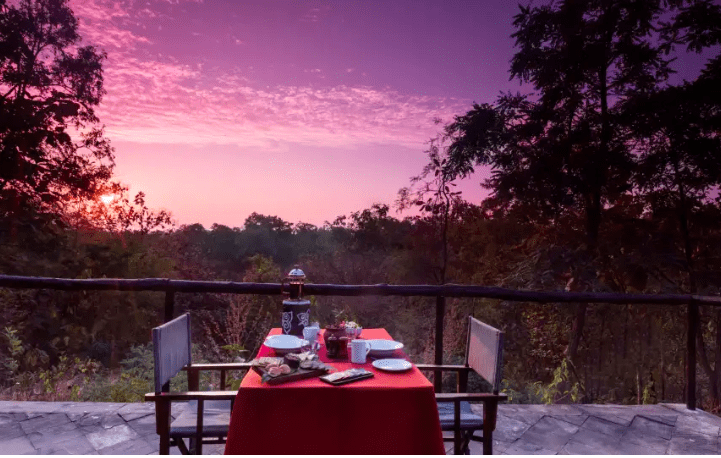
Gallery by Jehan Numa
